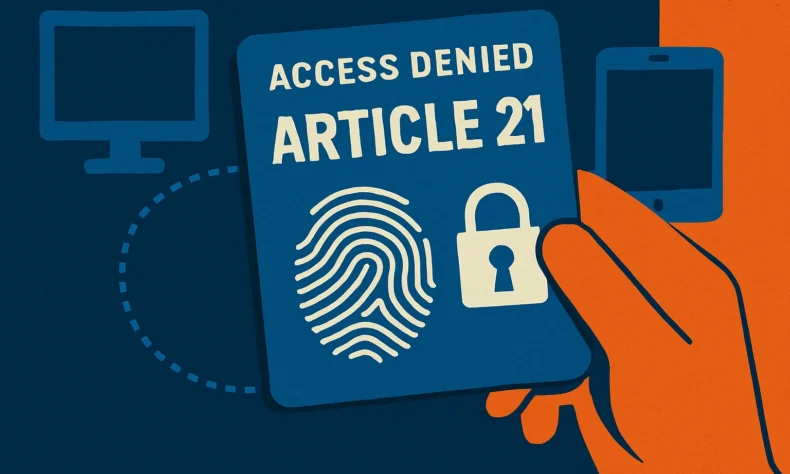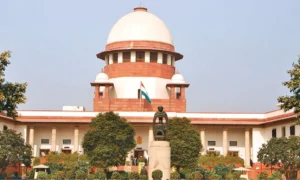
By Shivendra Pratap Santosh Singh
On April 30, 2025, the Supreme Court delivered a clear and humane message in a world where essential transactions, services and civic participation are increasingly digital, exclusion from digital systems can amount to a denial of the right to life with dignity. The Court took up two Public Interest Writs filed by acid-attack survivors and a person with total blindness who could not complete mandatory digital KYC procedures. After surveying statutory protections, international norms and sectoral rules, the Court directed regulators and departments to make digital onboarding and public digital platforms accessible and non-discriminatory.
WHY THIS RULING MATTERS NOW
The judgment situates the problem where it belongs; not as a narrow technology glitch but as a constitutional failing. Digital KYC and V-CIP procedures, created to combat fraud and money laundering, have become gatekeepers to bank accounts, telecom connections, pensions and many government services. When those procedures are designed without accessibility in mind, they exclude people who cannot meet visual liveness checks, capture signatures, or navigate inaccessible interfaces. The Court recognised that exclusion from digital systems may curtail autonomy and access to social and economic entitlements, and that the right to life under Article 21 “must be reinterpreted in light of these technological realities.”
THE FACTUAL PROBLEM THE COURT CONFRONTED
The petitioners described the practical barriers selfie-based capture that fails when faces are disfigured; liveness checks that rely on blinking or reading a code, which are impossible for blind persons; interfaces that do not work with screen readers; and biometric devices without speech output or tactile cues. Regulated entities often insisted on a “live photograph” embedded into the customer acquisition form and varied liveness tests. These measures, though framed as anti fraud steps, had the unintended effect of freezing out people with disabilities from essential services. The judgment sets these obstacles out carefully using the petitioners’ own accounts.
LEGAL ANCHORS: EQUALITY, REASONABLE ACCOMMODATION AND ACCESSIBILITY
The Court built its reasoning on a simple framework of rights and obligations. The Rights of Persons with Disabilities Act 2016 (RPwD Act) treats ‘reasonable accommodation’ as a statutory duty and requires the State to remove barriers to participation. The Act’s accessibility mandate and international obligations under the United Nations Convention on the Rights of Persons with Disabilities (UNCRPD) require proactive standards for information and communication technologies. The Court treated those statutory provisions as normative backstops to Article 21, concluding that the State must ensure that digital platforms and onboarding processes do not become instruments of exclusion.
WHAT THE COURT HELD AND THE DIRECTIONS IT ISSUED
Rather than striking down rules or asking petitioners to be content with apologies, the Court set practical, regulatory directions designed to be implementable. Key measures included:
a. Requiring all regulated entities, whether public or private to adopt and comply with recognised accessibility standards and to appoint nodal officers for digital accessibility compliance.
b. Mandating periodic accessibility audits by certified auditors and involving persons with blindness in user acceptance testing for apps and websites.
c. Directing the Reserve Bank to issue clarifications and frame alternatives to narrow “blinking-eye” liveness checks, and to permit other modes such as OTP-based face-to-face e-KYC, V-CIP, or human review where automated mechanisms fail.
d. Ordering regulators and service providers to accept images of thumb impressions for signature verification, to design KYC forms that record disability type and need for accommodation, and to preserve paper-based KYC as an accessible fallback in appropriate cases.
e. Requiring compliance with Web Content Accessibility Guidelines (WCAG) and India’s Guidelines for Indian Government Websites and Apps (GIGW), and asking for dedicated grievance redressal, helplines, and human review mechanisms for rejected applications.
Taken together these directions convert high-level constitutional obligations into concrete compliance points for regulators and providers.
BALANCING ACCESS AND SECURITY: THE COURT’S PRAGMATIC STANCE
Regulators had emphasised the anti-money-laundering rationale for strict liveness checks and the need to guard against spoofing. The Court acknowledged those concerns, but rejected the view that security trumps dignity. It observed that the RBI’s KYC Master Direction already recognises multiple modes, such as offline Aadhaar verification, OTP-based e-KYC and V-CIP among them, and that those modalities can be adapted to accommodate disabilities without sacrificing integrity. The Court therefore asked the RBI and sectoral regulators to issue clarifying guidance, and to ensure that safeguards like trained officers, geo tagging and transaction logs continue to deter fraud even as access widens.
WHAT THIS MEANS IN PRACTICE FOR PEOPLE AND INSTITUTIONS
For persons with disabilities the judgment promises immediate relief; ability to open bank accounts, receive pensions, obtain SIM cards and access welfare schemes without being forced to mimic visual gestures or navigate inaccessible apps. For institutions it signals a clear compliance roadmap: audit, redesign, document and train. Tech teams must embed screen-reader compatibility, audio captchas, alternative authentication flows, and accessible camera guidance into onboarding flows. Regulators must publish standards, permit reasonable alternatives, and ensure human-in-the-loop review for exceptional rejections. News coverage and expert commentaries have already begun to interpret the ruling as a pivot from optional accessibility to enforceable duty.
STANDARDS THE JUDGMENT INVOKES AND WHY THEY MATTER
The Court asks for compliance with established accessibility frameworks. In India, the GIGW builds on WCAG 2.1 Level AA and specifically addresses mobile app accessibility. National standards such as IS 17802 set minimum ICT accessibility requirements. By tying the Court’s directions to these standards the judgment gives regulators a tested technical baseline rather than an open-ended command. Implementing agencies should therefore map their digital estates to WCAG/GIGW checkpoints, commission accessibility audits and fix violations as a matter of priority.
A CONCISE ROADMAP FOR REGULATORS AND SERVICE PROVIDERS
1. Issue sectoral clarifications that define permissible liveness checks and list acceptable alternatives.
2. Mandate accessibility audits and publish timelines for remediation.
3. Build human review windows and helplines to resolve cases where automated systems fail.
4. Preserve feasible offline or assisted onboarding options where digital accommodation imposes disproportionate burdens.
5. Train front-line staff and third-party agents for sensitive, non-coercive assistance.
LIMITATIONS
A judgment is a beginning, not an instant fix. Technology vendors, small fintechs and telecom startups must overhaul interfaces and device ecosystems; some biometric hardware will need redesign. Budget, procurement cycles and legacy systems will slow implementation. To be effective, the Court’s directions need prompt regulatory rules, transparent timelines and public monitoring. Civil society and accessibility experts must be included in rule framing and audit design. International best practices and the Court’s push can together lower the compliance curve and make accessibility the default rather than an afterthought. Academic and policy commentators have urged such a joined-up approach after the ruling.
CONCLUSION
The Supreme Court’s judgment reframes digital inclusion as constitutional duty. By anchoring accessibility in Article 21 and the RPwD Act, and by prescribing operational directions, such as audits, alternative liveness checks, human review, WCAG/GIGW compliance, the Court has given regulators and the private sector a clear task: make digital systems work for everyone. The ruling recognises a simple truth. Technology is a public utility when it mediates basic civic life. Excluding citizens from that utility wounds dignity. The law now requires remedies that are technical, administrative and humane. The next test will be how faithfully rules convert into accessible code, accessible devices and accessible service on the ground. If implemented in letter and spirit, this judgment will have done more than correct a procedural injustice: it will have restored digital dignity to many who were denied it.
—Shivendra Pratap Santosh Singh is fourth-year student of BBA LL.B. (Hons.),
University of Mumbai Law Academy, Mumbai
📰 Crime Today News is proudly sponsored by DRYFRUIT & CO – A Brand by eFabby Global LLC
Design & Developed by Yes Mom Hosting






